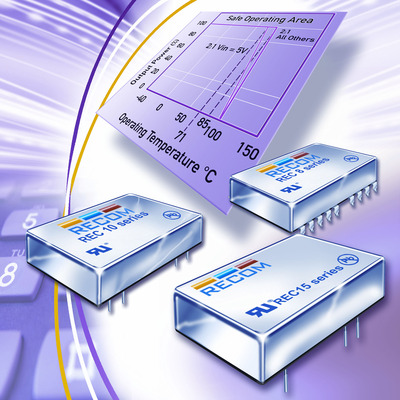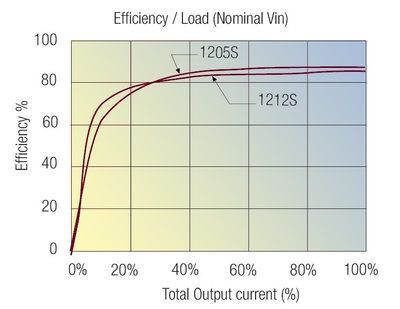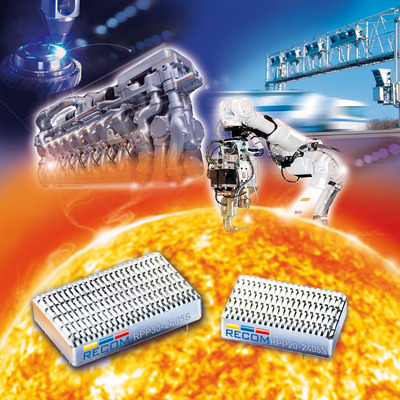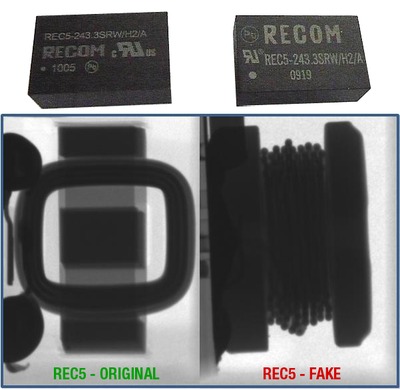Modular power supplies on the increase
Friday, 17 February, 2012
Modular power supplies enjoy disproportional growth. Personnel limitations of development engineers for discrete solutions increase costs, while readily available modules feature lower prices. Aspects such as higher efficiency, easier certification and the experience of specialists support ‘modular’ solutions.
A recently published analysis by RECOM suggests a trebling of the market share for modular converters during the next four years.
The circuit layout of isolated DC/DC-converters is principally simple. Two FETs on the primary side convert the DC voltage on the input with a frequency of several 100 kHz.

A transformer provides the isolation. Its number of turns N1/N2 defines the output voltage.
The secondary side is rectified and smoothed. Development tools in the internet suggest that the layout is quite simple. Insert the desired values into the program and the prototype is instantly available.
Thus far the theory. Reality looks quite different. The developer faces the principles of analog technology, things are never black or white. Circuit board tracks, on the diagram simple black lines without relevance, become suddenly capacitances or inductances, which are not ‘part of the program’.
This has consequences for the EMC of the circuit and the certification of the end product. Usually a number of ‘redesigns’ is necessary until the desired limits are met.
The transformer also has its problems. Its functionality depends on the ferrite material used and the range it has to operate in on the saturation curve (hysteresis).
If too saturated it tends to heat up with a corresponding reduction of its magnetic behaviour. This too is not simply ‘black or white’ and not easy to calculate.
The design of an optimised DC/DC converter with high efficiency and low interference requires a lot of experience.
Provided the user has this kind of experience, the user can save some money in designing a ‘discreet’ converter, particularly for high volume.
Commercial success of an electronic product depends on the time scale of its market introduction.
The use of modular solutions definitely reduces time and minimises risks. If an end product fails the certification process due to a discreet, designed converter showing higher interference limits, the delay is likely to be months rather than weeks.

Even a specialist company as Recom, having manufactured many millions of converters, reserves several months to develop a new family. Especially time consuming is the optimisation of the design, the realisation of top performance percentages, that usually falls short in the development of a discreet solution.
Development engineers have to fight for ever smaller ‘energy budgets’, since energy consumption has become a ‘buy factor’. They have to focus on processors, graphic chips and converters within a design.

As an example: In a circuit eight discrete 15 W converters supply each +5 V or -5 V output and their efficiency is around 75% and the effective 15 W power is achieved with losses of 5 W per converter - in total 40 W.
Quite different is the power requirement when a modular supply, trimmed for highest efficiency, is used. Recom’s REC15, for example (Figure 3), reaches an efficiency of 87% in this application, causing losses of only 2.25 W per module, ie, 55% less than the in-house discrete solution.
These efficiencies apply only to converters operated close to full load. Lower loads cause lower efficiency, which falls to close to zero under no-load conditions. What happens under changing load condition is displayed in Figure 3.
The REC15 still reaches an efficiency of more than 80% with 30% rated load. A comparable discrete solution would have little more than 50%.
‘Efficiency’ is not only relevant for energy saving, but also for heat losses and operating temperature of the complete design.
Twenty-two watt reduced losses also mean lower temperatures within the circuit and therefore reduced cooling that depends on the size of the fan. A fan is best eliminated, since it requires space, consumes energy, generates noise and transports dust.
For that reason, converters operating at temperatures of +65°C and more are in increasing demand. The company offers, with the RPP family, power converters up to 50 W for operation in an ambient temperature of +100°C, without de-rating. Converters of the RPP family operate safely down to -55°C.

The trend for miniaturisation continues making an additional advantage of modular power supplies. Their ‘footprint’ is much smaller than for discrete solutions and this alone often justifies their higher price.
Additionally, potted converters are protected against environmental influences, such as shock and vibration. For testing and optimisation of its converters, the company operates an environmental laboratory in Gmunden, Austria, where prototypes in early development stages can be evaluated.
HALT tests simulate long-term behaviour of modules in enforced conditions. Correspondingly high is their lifetime.
A source of increasing concern is counterfeit products, largely of Chinese origin, which reach the market through dubious channels.
It seems enticing to offer identical-looking products with falsified marking, including safety markings, for below standard products and below market prices.
The resulting damage rests with the purchaser, since these products are void of any warranty.
A German machine manufacturer incurred significant costs when he had to replace counterfeit REC5 converters. A check with an electronic microscope showed primary and secondary windings overlapping (Figure 5), without regard to the specified isolation values.

Although the counterfeit product outwardly looked nearly identical to the original, its inner design did not meet minimum quality standards and led to large-scale field failures after a few months’ operation.
The trend of replacing discrete converter designs with certified modules continues. The user saves development time and board space and usually receives a product with much enhanced specifications, especially efficiency and isolation.
These advantages easily compensate for the higher price.
Soft robot uses magnetic fields to power itself autonomously
Inspired by the movement of manta rays, researchers have developed a small, magnetically powered...
Perovskite 'energy sandwich' could power next-gen solar
Researchers have achieved a new level of control over the atomic structure of halide perovskites,...
Creating the truck of tomorrow
Exploring the technological innovations, infrastructure solutions and emerging delivery methods...





